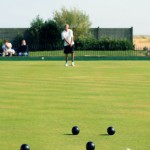
Following on from yesterdays post on Performance Green Properties, the ideal bowling green then, will be uniform in terms of appearance, pace and consistency of play over the whole green and over the season. We will probably see an increase in pace as the summer progresses, but we shouldn’t see too many fluctuations in this pace during an average season.
This consistency is achievable, but only by first getting the green into a condition where it has returned to behaving as one living eco system. This means that the green will demonstrate some very specific attributes. Today we will consider the surface properties of such a green. It will need the following :
Grasses.
The grasses we use to produce the surface will need to demonstrate the following attributes:
- Fine leafed with an upright growth habit
- Slow re-growth after cutting
- Resistance to wear, disease, drought, and cold with a fast recovery rate from wear and damage.
- Deep green, uniform colouration
All of the above points us to the finer Bent and Fescue Grasses. So now that we know the kind of surface we need and the kind of grass sward we need in order to achieve this surface we can start to define the ideal growing conditions required by such a sward.
Weeds.
It goes without saying that there should be no weeds in the green surface and by weed I mean any plant life that can disrupt the playing surface. Now, most weeds are obvious because they are broad-leafed and show up in stark contrast to the grass surrounding them. However, there are a few less obvious weeds that can also cause inconsistency on the playing surface such as pearlwort and yarrow and these can sometimes be hard to spot and eradicate, Yellow suckling clover is another difficult weed to deal with.
In addition to the weeds proper referred to above, many greenkeepers who would also consider annual meadow-grass (Poa annua) to be just as bad a weed pest as any dandelion or daisy, but the hard truth is that many greens are so badly infested with this grass that to get rid of it quickly would be to get rid of the majority of the grass sward, leaving the green in a very poor state.
The good news is that the approach required to achieve a performance green outlined in this book will gradually make your green unattractive and unaccommodating to both broad-leafed weeds and weed grasses like annual meadow grass.
Diseases and Disorders
In addition to rogue grasses and weeds the surface can be disrupted by a plethora of different pathogens that directly interact with the grass, usually to its detriment and that of the green surface. These are almost always fungal diseases and some of the more common are fusarium, red-thread and snow mould.
Sometimes confused with diseases are a series of other green defects usually labelled as disorders. These are generally not pathogenic, so don’t directly damage the grass plants, but their effects can be just as devastating to bowling greens. These include slimes and squidge usually associated with acidic soil conditions and the very problematic Localised Dry Patch, associated with thatch, over use of sand and irrigation problems.
Again though, there is nothing to worry about because like we saw with unwanted grasses and weeds in the sward, the conditions required to produce a consistently high performance green will make your green extremely unattractive to these troublesome disorders and diseases.
Green sub-surface requirements for high performance.
The soil we use to support both the structure of the bowling surface and to sustain the grasses required for a high performance surface will require the following attributes:
- A strong, stable soil structure that resists compaction and wear.
- A healthy, living soil that retains sufficient moisture and nutrients to sustain a healthy sward of fine grass.
- A free draining medium able to cope with heavy periods of rain without puddling excessively and which drains quickly after heavy rainfall.
We will keep exploring this and tomorrow I’ll be looking at the sub surface requirements for performance; what goes on beneath?
